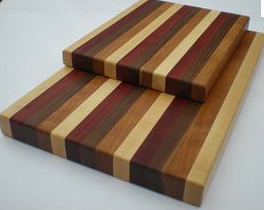Think about your kitchen: Do you have wooden cutting boards, plastic cutting boards, both or none?
If the answer is none, read this post and then get thee to a local cookware store or farmers market, pronto. Your cooking experience soars when you have the right equipment and a good cutting board is absolutely essential.

Good cutting boards are essential in any kitchen; wooden boards have many advantages, including beauty
I have several wooden cutting boards, two large ones that sit on my counter all the time and several smaller ones that I use now and then. I prefer wood for several reasons. First, it is aesthetically pleasing while plastic, clearly, is not. More importantly, wood is easier on knives; plastic wears down a knife’s sharp blade quickly. Finally, several studies have settled the issue of which is safer, wood or plastic.
Wood is safer. There are natural antibacterial and antimicrobial properties in wood which eliminate about 99 percent of all potential contaminants. Even when plastic cutting boards are washed with hot soapy water or put through a dishwasher, they continue to breed bacteria.
Health departments were slow to acknowledge the studies that indicated wood was the best choice for cutting and prepping surfaces in kitchens.
When I was running a restaurant in Sonoma County in the mid 1980s, an environmental health inspector began insisting that we replace our beautifully aged enormous wooden cutting tables with stainless steel and plastic. There was some flexibility because we were grandfathered in–i.e., we were already in business when the new requirements were established–but we were told we must begin the transition to a woodless kitchen. I left the restaurant not long after the transition was complete.
Jump forward a decade, when I was writing for what was then called The Sonoma County Independent (now The North Bay Bohemian). I had come across a study by the University of Wisconsin that validated my strong instinct that wood was the right choice. Then I found a second study by the University of California. I called the local health department and interviewed a supervisor, who explained that food-grade wooden cutting boards and other wooden surfaces were now permitted. When I pressed for a recommendation, he said they still preferred plastic.
Why? I asked.
“It is lighter and you can put plastic in a dishwasher,” he said. He wouldn’t budge on this point but finally, I thought of the right question.
“What do you use at home?” I asked.
There was a pause and then his answer came, with just a bit of exasperation.
“Wood,” he said.
Touchdown!
Today, you can find something on the internet to support any side of any argument. If you want to believe that plastic is preferable, you’ll find plenty of postings that back you up. The same is true if you want to believe that wood is best.
How do you sort it all out?
Personally, I put more trust in nature and in history than I do in plastic manufacturers. I also feel confident about the in-depth studies I have read and I trust instinct and intuition, especially when it is informed by knowledge. In addition, I love my knives and prefer to keep them as sharp as possible. Finally, I have always been a sensualist. I love the look, feel and sound of wood, qualities that make the cooking experience more pleasing than when I must use plastic.
There’s one more ingredient that should be a part of every kitchen: common sense. Don’t, for example, risk cross-contamination, which is to say don’t chop a vegetable (or anything else, for that matter) on a cutting board that has just been used for raw meat, seafood or poultry. Clean it first! Always wash cutting boards with hot soapy water between uses. If you do a lot of cooking, it is convenient to have several cutting boards, reserved for specific ingredients (one for proteins, for example, one for vegetables, one for breads).
Finally, if your only experience is in a home kitchen, you might be frustrated by the way some cutting boards slip on certain surfaces. This is easily mitigated. For cutting boards that will remain in one place for a considerable amount of time, I recommend a plastic mat. They are inexpensive and readily available at almost any cookware store. For a cutting board that will be used and then stored elsewhere, you can simply set a tea towel underneath it. This is not recommended for a cutting board that will remain in one place for a long time, as the towel will inevitably absorb water and other liquids and will breed bacteria.
A great place to look for wooden cutting boards is your local farmers market, especially at this time of year, when crafters often offer their best items for holiday shoppers.

